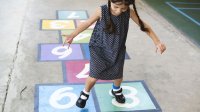The Brain Is Wired for Math—Sort Of
Symbolic math can be hard to grasp, so we have tips to help you build on the natural math sense your kids already have.
While genetics and gender play a role in math achievement, classroom teaching can pick up the slack and help kids soar. Three keys? Make math understandable, useful, and beautiful. This is no small task, but you have 23 (or so) helpers in your classroom who can make the job manageable if you work with their natural abilities and motivations.
Make It Understandable
Early childhood educator Donna Z. Falcone once said to me that children often feel math is trying to trick them. Why would that be?
Like learning to read, learning symbolic math is one of the hardest tasks a child will ever undertake. Many aspects of symbolic math require multiple brain pathways that, as with reading, must eventually process in parallel. So learning math takes time and practice.
Fortunately, most people possess some very natural math capabilities. For instance, we have a built-in number sense that can tell one from two from many, and we seem to line up quantities on a mental number line. Our brains are also natural calculators when it comes to handling perceptions like visual size-distance scaling. And babies’ brains use statistical analysis to learn language.
We’re wired for math—sort of.
The tricky part comes when we take our natural math sense and introduce it to the needs of a symbolic math system that promises to take us far past our natural abilities, if only we can learn the system’s intricacies.
One part of the brain primarily responsible for natural math sense is visual-spatial, and this is where you can really get those 23 classroom helpers to assist you fairly easily, because children often love visual-spatial tasks. We teachers can know we’re helping them enhance capabilities that have been found to have high correlation with math achievement, and they’ll experience such tasks as simply having fun.
To plan in this regard, choose classroom games and activities that develop a mental number line, strengthen the ability to mentally rotate objects in space, and increase shape-copying finesse.
Simple linear and spatial relationship tools like finger-counting, linear games like hopscotch, games that put us in spatial relationship to one another like “Mother, May I?,” building with blocks, using an abacus, making origami, quilting, pattern-making, and copying simple geometric shapes are star contenders for visual-spatial enhancement.
On the symbolic math side, which relies heavily on phonological processing and other linguistic brain functions, we can mitigate math’s trickiness by increasing verbal math activities—especially ones that link back to visual-spatial tasks. Counting off and counting everything, while involving the body (especially hands), goes a long way. The possibilities are endless: Count off for lining up or for any number of classroom needs that require movement, do morning stretches while counting the duration, count during jumping rope, count the blocks as towers are built, and use fingers to tap out and count the beats in words during literacy activities.
Make It Useful
Children are drawn to what feels useful, and they’re empowered when they can successfully apply or manipulate useful processes and objects. The lack of perceived usefulness in math is a motivation killer, according to Stanford professor Jo Boaler.
To reveal the usefulness of symbolic math, it’s logical to use a child’s own practices—and limitations—to spur learning. Tracking changes (such as one’s height versus a friend’s, one plant’s growth versus another’s, or the evaporation of water from a covered jar versus an open jar), keeping score in competitions and games (which becomes quite unwieldy if you can’t count or add), and documenting progress of many kinds are great ways to move a child into wanting to use symbolic math for real purposes.
Make It Beautiful
New ideas about how beauty affects learning—especially by provoking interest and producing learning pleasure—are especially intriguing for teaching symbolic math, which rarely gets a good beauty treatment. Since learning symbolic math requires intense and prolonged effort, it’s worth looking into the beauty factor to significantly boost the required motivation.
It’s best to keep the beauty inside well-told and gorgeously illustrated stories like One Grain of Rice. Or you can use visual-spatial tasks with strong and streamlined edges like those recommended above—making origami, quilting, pattern-making, and simple shape copying—to experience the particular beauty of math. Gesture drawing and schematics can work well also, as they reveal the inner structure and rotation lines of objects, buildings, even journeys (think maps drawn with a Zen-like quality).
The ability to streamline something visually, to see its inner lines, outer edges, rotations, or paths without embellishment is associated with higher math achievement. Embellishments can take the focus off the math. For the child who wants to embellish, a gesture drawing or schematic could be drawn either in the planning stages of a drawing or building project or as an overlay or map after the project is completed.
Going Forward
Your classroom is full of children who, with the exception of those with developmental impairments, have natural math sense and linguistic abilities. Making math more understandable, useful, and beautiful will go a long way toward reducing symbolic math’s tricky side, and it can help children pair their natural math sense with symbolic math—for a bright math future.
